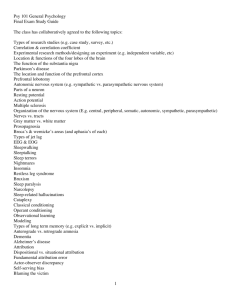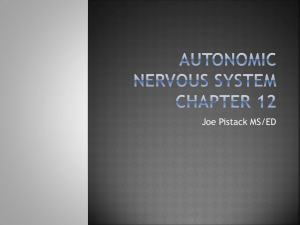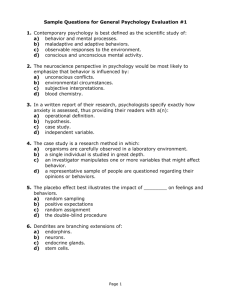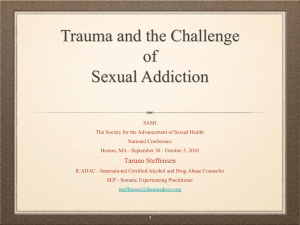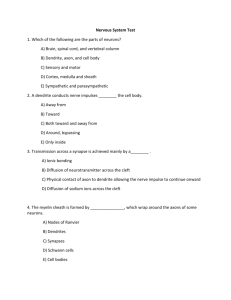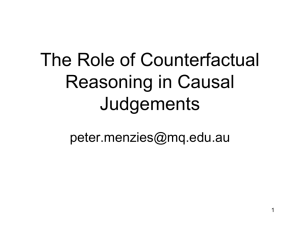The Psychology of Love -
advertisement
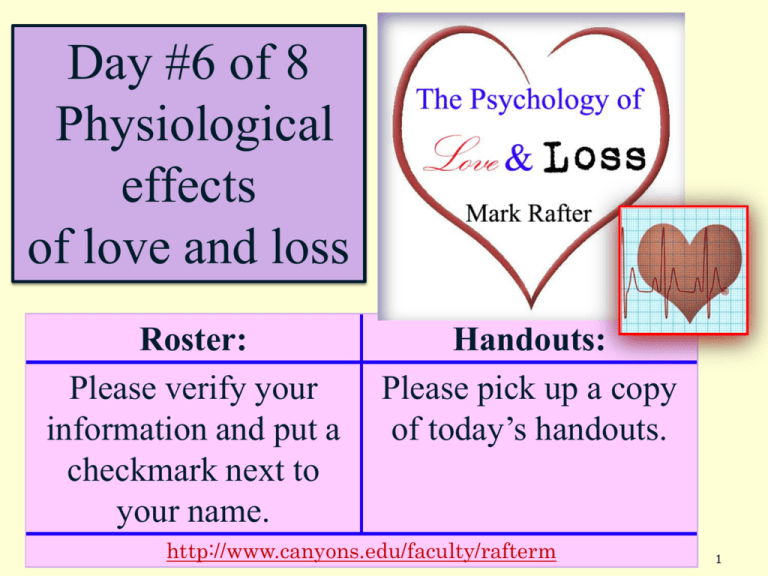
Day #6 of 8 Physiological effects of love and loss Roster: Please verify your information and put a checkmark next to your name. Handouts: Please pick up a copy of today’s handouts. http://www.canyons.edu/faculty/rafterm 1 The Psychology of Love & Loss The Physiological Effects of Love & Loss Day #6 of 8 Adaptive Function of the Autonomic Nervous System (Hans Seyle) Post-traumatic Stress Disorder (PTSD) Psychological Hardiness/Resilience The Autonomic Nervous System It is the interface between our central nervous system and our internal organs, glands, and smooth muscle tissue. It serves to monitor and regulate our internal environment. 3 The Autonomic Nervous System Parasympathetic Sympathetic Branch Branch Relaxed & Safe (old home) Adapted/Habituated Bladder Walls contract Bladder Sphincter Muscle is not contracted Conserve energy (Sleep/Feed&Breed) Lacrimal gland secretes Possible Parasympathetic Overshoot after intense excitement 4 • • • • • • Excited & On Alert (new) Novelty Effect – Orienting Bladder Walls are not contracted Bladder Sphincter Muscle contracts Burn energy (Fight/Flight&Freeze) Dry/burning eyes The Autonomic Nervous System Parasympathetic Sympathetic Branch Branch Relaxed & Safe (old home) • • (…from Polyvagal Theory) • The receptive Social • Engagement System • links face & heart responses. Dampens the stress response for enjoyable social interaction. 5 Excited & On Alert (new) Fight/Flight/Freeze responses Shut-down behaviors Dissociative experiences Fainting HANS SELYE • Hans Hugo Bruno Selye, was a pioneering Hungarian endocrinologist. He conducted much important scientific work on the hypothetical non-specific response of an organism to stressors. Wikipedia • Born: January 26, 1907, Vienna • Died: October 16, 1982, Montreal 6 Hans Selye’s General Adaptation Syndrome G.A.S. “The body’s non-specific response to stressful events.” • Alarm • Resistance • Exhaustion 20 Alarm 15 10 Sympathetic Branch (Fight or Flight) 5 0 1 -5 -10 2 3 4 5 6 7 Parasympathetic Branch (Feed or Breed) 8 9 10 11 12 13 14 15 16 17 Parasympathetic Overshoot 18 19 General Adaptation Syndrome 20 Alarm Resistance 15 10 5 0 1 2 3 4 5 6 7 8 9 10 11 12 13 14 15 16 17 18 19 20 21 22 23 24 25 26 27 28 29 30 31 32 -5 -10 -15 Exhaustion General Adaptation Syndrome 20 Alarm Resistance 15 10 5 0 1 2 3 4 5 6 7 8 9 10 11 12 13 14 15 16 17 18 19 20 21 22 23 24 25 26 27 28 29 30 31 32 -5 -10 -15 Exhaustion General Adaptation Syndrome 20 Alarm Resistance 15 10 5 0 1 2 3 4 5 6 7 8 9 10 11 12 13 14 15 16 17 18 19 20 21 22 23 24 25 26 27 28 29 30 31 32 -5 -10 -15 Exhaustion PSYCHOSOMATIC ILLNESS Illness affected by the interaction of the mind (psyche) and the body (soma) Psychoneuroimmunology (PNI) is the multidisciplinary study of the interaction between psychological processes and the nervous and immune systems of the human body. Instances include the following: Respiratory, cardio-vascular, muscular, sleep, gastro-intestinal, anxiety-related, nervoussystem, immune-system (viral & allergy), and attention-related (slip-and-fall injuries). Categories of Post-Traumatic Stress Disorder (P.T.S.D.) Intrusive Avoidant Hyperarousal 14 CATEGORIES OF P.T.S.D. Intrusive Recurrent intrusive memories of the trauma Recurrent and distressing dreams of the trauma Avoidant Hyperarousal Avoiding Difficulty falling thoughts, feelings asleep or staying or conversations asleep about the trauma Avoiding Difficulty activities, places concentrating or people that remind of the trauma CATEGORIES OF P.T.S.D. Intrusive Flashbacks of the trauma Intense psychological distress when exposed to reminders Avoidant Hyperarousal Difficulty Feeling alert or remembering watchful when important aspects there is no need of the trauma to be Loss of interest or Exaggerated and pleasure in frequent startle normal activities response Feeling distant or cut off from others CATEGORIES OF P.T.S.D. Intrusive Avoidant Physical distress when reminded (heart racing, shaking) Difficulty experiencing normal feelings such as love and happiness Feeling that the future will be cut short Hyperarousal THE TAROT CARD DEATH CARD • A symbolic representation of change • Two responses to the reality of change right-side up or up-side down Represents the death of the old self. Not only physical death. Transformation. Change. Destruction followed by transformation. A change in consciousness. Looking forward to what will be. Renewal. Change. right-side up Stagnation. Inertia. Stuck. Change A focus on what once was. Looking back longingly. Lamenting what was lost. up-side down I don’t want anything to change. Start at (00:49) DABDA-REVISITED • DABDA Denial, Anger, Bargaining, Depression, Acceptance • Bargaining Counterfactual Thinking is a form of retro-active bargaining. We create our reality based on how we perceive the energy in the universe. Counterfactual Thinking: our tendency to imagine alternatives to reality. (a) We think about how things could have turned out differently. “If only...”, & (b) We imagine, “What if...?” These thoughts affect our emotions and our overt behaviors. After an accident… COUNTERFACTUAL THINKING our tendency to imagine alternatives to reality Daniel Kahneman and Amos Tversky pioneered the study of counterfactual thought, showing that people tend to think 'if only' more often about exceptional events than about normal events. There are many different possible futures and only one life to live. Commitment to one of the possible alternatives adds clarity and reduces uncertainty. 24 Counterfactual Thinking • Upward comparisons with better possible outcomes trigger regret. Remorse after loss. • The capacity to experience regret is uniquely derived from counterfactual thinking. • Downward comparisons with worse possible outcomes trigger relief. Gratitude after love. 25 26 27 The Three C’s Characteristics of Psychological Hardiness/Resilience • Control • Challenge • Commitment CONTROL Internal Locus of Control Empowered Decision Maker Danger Avoider External Locus of Control Fated Order Taker Helpless CHALLENGE Optimistic Pessimistic Lemonade Maker Lemon Lamenter Opportunity Focus Loss Focus See a Silver Lining See a Storm Cloud Feels Fortunate Feels Abused The Car & The Home COMMITMENT Energy for the Moral Center This is for me! This helps me! I am energized! Feels Fortunate participating in this relationship Energy for the Marginalized This is for them! This hurts me! I am drained! Feels Used & Abused participating in this relationship The Three Blessings Exercise Directions • At the end of each day, write down three things that happened to you for which you are grateful. • Everyday, share your gratitude with another person. Elizabeth Taylor talks about Beauty 36 Optimism As we take everything to heart, may we be receptive and enjoy all the fruits of our lives. 38


